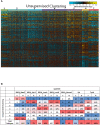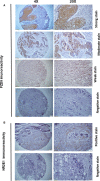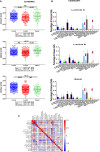M1 Polarization Markers Are Upregulated in Basal-Like Breast Cancer Molecular Subtype and Associated With Favorable Patient Outcome
- PMID: 33304345
- PMCID: PMC7701279
- DOI: 10.3389/fimmu.2020.560074
M1 Polarization Markers Are Upregulated in Basal-Like Breast Cancer Molecular Subtype and Associated With Favorable Patient Outcome
Abstract
Background: Breast cancer heterogeneity is an essential element that plays a role in the therapy response variability and the patient's outcome. This highlights the need for more precise subtyping methods that focus not only on tumor cells but also investigate the profile of stromal cells as well as immune cells.
Objectives: To mine publicly available transcriptomic breast cancer datasets and reanalyze their transcriptomic profiling using unsupervised clustering in order to identify novel subsets in molecular subtypes of breast cancer, then explore the stromal and immune cells profile in each subset using bioinformatics and systems immunology approaches.
Materials and methods: Transcriptomic data from 1,084 breast cancer patients obtained from The Cancer Genome Atlas (TCGA) database were extracted and subjected to unsupervised clustering using a recently described, multi-step algorithm called Iterative Clustering and Guide-gene Selection (ICGS). For each cluster, the stromal and immune profile was investigated using ESTIMATE and CIBERSORT analytical tool. Clinical outcomes and differentially expressed genes of the characterized clusters were identified and validated in silico and in vitro in a cohort of 80 breast cancer samples by immunohistochemistry.
Results: Seven unique sub-clusters showed distinct molecular and clinical profiles between the well-known breast cancer subtypes. Those unsupervised clusters identified more homogenous subgroups in each of the classical subtypes with a different prognostic profile. Immune profiling of the identified clusters showed that while the classically activated macrophages (M1) are correlated with the more aggressive basal-like breast cancer subtype, the alternatively activated macrophages (M2) showed a higher level of infiltration in luminal A and luminal B subtypes. Indeed, patients with higher levels of M1 expression showed less advanced disease and better patient outcomes presented as prolonged overall survival. Moreover, the M1 high basal-like breast cancer group showed a higher expression of interferon-gamma induced chemokines and guanylate-binding proteins (GBPs) involved in immunity against microbes.
Conclusion: Adding immune profiling using transcriptomic data can add precision for diagnosis and prognosis and can cluster patients according to the available modalities of therapy in a more personalized approach.
Keywords: basal like; breast cancer; macrophages; transcriptomic; tumor infiltrated immune cells.
Copyright © 2020 Hachim, Hachim, Talaat, Yakout and Hamoudi.
Figures








Similar articles
-
Gene-expression molecular subtyping of triple-negative breast cancer tumours: importance of immune response.Breast Cancer Res. 2015 Mar 20;17:43. doi: 10.1186/s13058-015-0550-y. Breast Cancer Res. 2015. PMID: 25887482 Free PMC article.
-
Immune gene expression profiling reveals heterogeneity in luminal breast tumors.Breast Cancer Res. 2019 Dec 19;21(1):147. doi: 10.1186/s13058-019-1218-9. Breast Cancer Res. 2019. PMID: 31856876 Free PMC article.
-
High-grade serous tubo-ovarian cancer refined with single-cell RNA sequencing: specific cell subtypes influence survival and determine molecular subtype classification.Genome Med. 2021 Jul 9;13(1):111. doi: 10.1186/s13073-021-00922-x. Genome Med. 2021. PMID: 34238352 Free PMC article.
-
Single-Cell RNA Sequencing in Lung Cancer: Revealing Phenotype Shaping of Stromal Cells in the Microenvironment.Front Immunol. 2022 Jan 19;12:802080. doi: 10.3389/fimmu.2021.802080. eCollection 2021. Front Immunol. 2022. PMID: 35126365 Free PMC article. Review.
-
Tumor-Associated Macrophages as Multifaceted Regulators of Breast Tumor Growth.Int J Mol Sci. 2021 Jun 18;22(12):6526. doi: 10.3390/ijms22126526. Int J Mol Sci. 2021. PMID: 34207035 Free PMC article. Review.
Cited by
-
In Silico Analysis of Publicly Available Transcriptomic Data for the Identification of Triple-Negative Breast Cancer-Specific Biomarkers.Life (Basel). 2023 Feb 2;13(2):422. doi: 10.3390/life13020422. Life (Basel). 2023. PMID: 36836779 Free PMC article.
-
Modulatory role of miRNAs in thyroid and breast cancer progression and insights into their therapeutic manipulation.Curr Res Pharmacol Drug Discov. 2022 Oct 3;3:100131. doi: 10.1016/j.crphar.2022.100131. eCollection 2022. Curr Res Pharmacol Drug Discov. 2022. PMID: 36568259 Free PMC article. Review.
-
Antitumor therapy for breast cancer: Focus on tumor-associated macrophages and nanosized drug delivery systems.Cancer Med. 2023 May;12(10):11049-11072. doi: 10.1002/cam4.5489. Epub 2023 Feb 16. Cancer Med. 2023. PMID: 36794651 Free PMC article. Review.
-
GBP5 Expression Predicted Prognosis of Immune Checkpoint Inhibitors in Small Cell Lung Cancer and Correlated with Tumor Immune Microenvironment.J Inflamm Res. 2023 Sep 20;16:4153-4164. doi: 10.2147/JIR.S401430. eCollection 2023. J Inflamm Res. 2023. PMID: 37750170 Free PMC article.
-
Exploring Prognostic Gene Factors in Breast Cancer via Machine Learning.Biochem Genet. 2024 Dec;62(6):5022-5050. doi: 10.1007/s10528-024-10712-w. Epub 2024 Feb 21. Biochem Genet. 2024. PMID: 38383836
References
-
- Peart O. Metastatic Breast Cancer. Radiologic Technol (2017) 88(5):519m–39m. - PubMed
Publication types
MeSH terms
Substances
LinkOut - more resources
Full Text Sources
Medical

